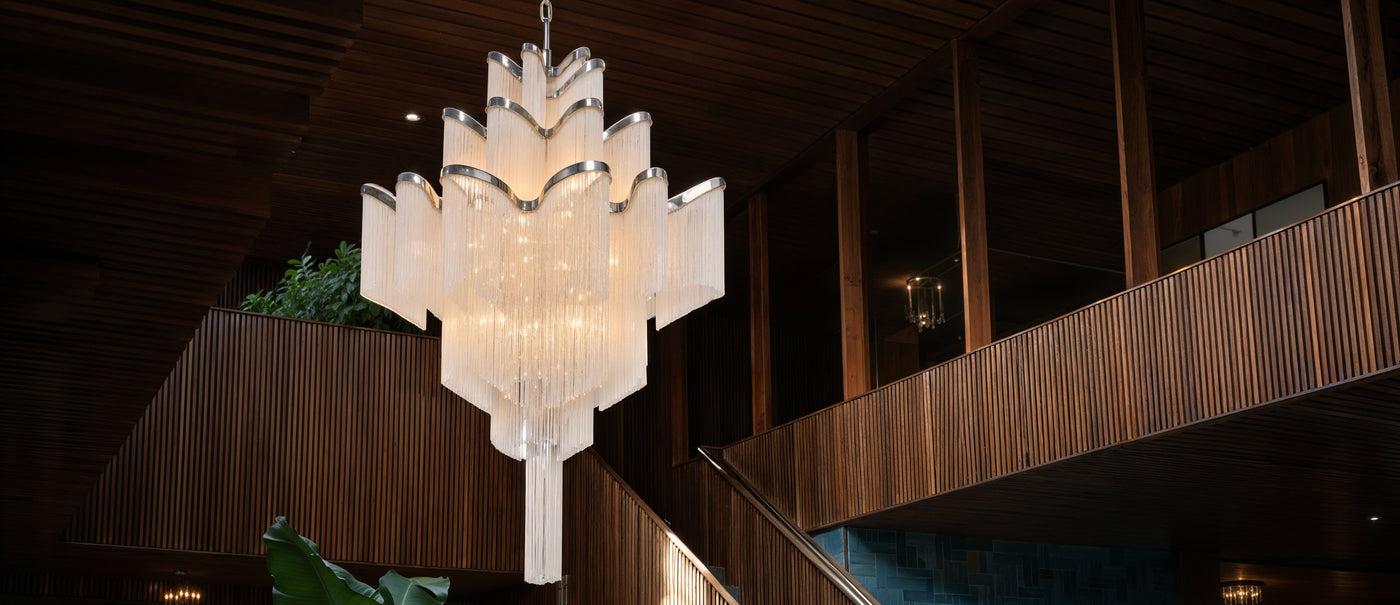Ascending Chandelier Glow
Staircases sit at the intersection of circulation and architecture. You pass through them multiple times a day, you see them from different angles, and they often carry more vertical height than any other part of the home. The chandelier you place here needs to respect that height, provide reliable light, and stay clear of handrails and walking paths. A standard chandelier can look out of scale or hang too low in a stairwell. This is where a staircase-specific fixture earns its place.
Shop Modern Lamp Lighting
- Lamp Collections: Modern Floor Lamps | Floor Lamps | Modern Table Lamps | Table Lamps | Desk Lamps
- Lamp Pieces: Reading Lamps | Bedside Table Lamps | Living Room Floor Lamps | Living Room Table Lamps | Minimalist Lamps
- Guides & Inspiration: Lighting Design Journal | How to Layer Lighting in a Living Room | Choosing the Perfect Modern Lamp | Modern Floor Lamp Ideas | Ambient, Task & Accent Lighting Explained
Staircase Chandeliers Fixture
Staircase chandeliers lights are ceiling-mounted fixtures built for spaces with a longer vertical drop, such as stairwells, open foyers, and multi-story landings. They provide general illumination for safe movement while giving the stair area a clear focal point that reads well from the ground floor and the upper level.
In a staircase, you do not view the fixture from a single position. You see it from below, from the landing, and often from an adjacent hallway. That makes proportion and visibility as important as brightness. Many stairwells also have sloped ceilings or offset junction boxes, so the canopy and hanging system matter more than they would in a standard room.
Product Options
Different staircase layouts call for different chandelier forms. The right choice depends on ceiling height, the width of the stair opening, and how close the fixture will sit to the railing line.
Vertical Chandeliers
Vertical chandeliers suit stairwells with a strong height component, including double-height entry staircases. Their elongated shape fills the vertical space without requiring a wide footprint, which helps when the staircase turns or curves.
Cascading and Multi-Drop Chandeliers
Cascading fixtures use multiple drops to create a tall profile with softer distribution across levels. This format can work well when you want the fixture to remain visible from both floors without relying on a single large body. Pair with pendant lights for layered illumination in adjacent spaces.
Lantern-Style Chandeliers
Lantern forms provide a structured silhouette that pairs well with traditional and transitional interiors. They often offer a defined frame that stays visually clear from a distance, which helps in open foyers.
Round and Tiered Chandeliers
Round chandeliers and tiered styles can work in staircases with a wider opening and more clearance from the railing. They can also suit straight stair runs where you have space to centre the fixture without crowding the edges.
Key Lighting Principles
Scale and Ceiling Height
Start with the opening, not the stair tread. If your staircase sits under an open void, measure the width of that opening and choose a chandelier diameter that sits comfortably within it. As a practical range, a diameter around one third to one half of the opening width often reads balanced, provided the fixture does not push into the railing line when viewed from the side.
For height, aim for a fixture length that makes use of the vertical volume without creating a low point in the path of travel. If the staircase is visible from multiple levels, a taller fixture usually reads better than a short one because it holds presence from both viewpoints.
Light Quality
Staircases need clear, comfortable light rather than high-intensity task brightness. Diffused light helps reduce harsh shadows on steps and avoids glare when you look up. If you plan to use a dimmer, it can help you shift from brighter daytime circulation to softer evening lighting without changing fixtures.
Sloped Ceiling Compatibility
Many stairwells sit under pitched ceilings. If that applies to your home, check whether the chandelier can mount to a slope, or whether it uses a swivel canopy. This detail affects how straight the fixture hangs and how centred it looks once installed.
Shop by Category
If you want to coordinate staircase lighting with nearby spaces, these related collections can help you keep finishes and forms consistent:
Chandeliers
Ceiling Light fixture
Pendant Lights
Wall Sconces
Placement Tips for Your Home
Straight Staircases
Centre the chandelier along the main run or over the most visible portion of the staircase. If your stairwell includes a landing, positioning



























































































































































































































































































